 Big Red wins both Ivy basketball titles. It had never happened. Cornell had never captured both the men's and women's Ivy League basketball championships in the same year.
Big Red wins both Ivy basketball titles. It had never happened. Cornell had never captured both the men's and women's Ivy League basketball championships in the same year.
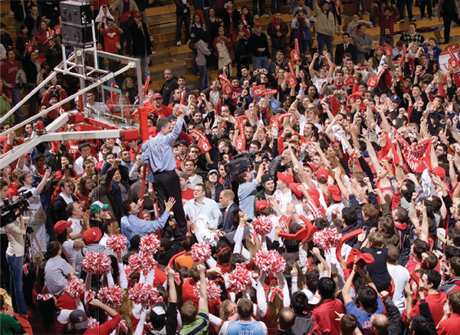 Big Red wins both Ivy basketball titles
Big Red wins both Ivy basketball titles
It had never happened. Cornell had never captured both the men's and women's Ivy League basketball championships in the same year. In fact, the men had won the title only once, twenty years ago, and the women had never won it.
Yet there was men's head coach Steve Donahue, cutting down the net in Newman Arena after the Big Red defeated Harvard 86-53 on March 1 to complete a perfect Ivy season and clinch a spot in the NCAA Tournament. Then, fifteen days later, women's head coach Dayna Smith repeated the net-cutting ritual after her team dismantled Dartmouth 64-47 to earn its own trip to the Big Dance.
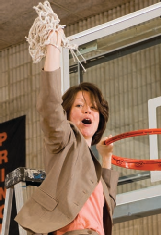
For both squads, the road to the championship was far from easy. After a promising 4-1 start, the men suffered three straight losses to Colgate, Bucknell, and Syracuse. But, says Donahue, those defeats became the turning point for his players. "We were scoring a lot but weren't guarding," he explains. "We were kind of searching for ourselves—but from then on, we realized that we were going to have to get tough on defense."
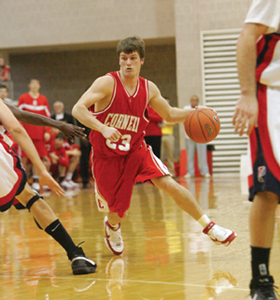
The Big Red won their next three games, and then, on January 6, faced the Duke Blue Devils in Durham, North Carolina, in a nationally televised contest. They lost 81-67, but their strong effort against a perennial powerhouse would prove to be the men's last loss of the regular season. In an unprecedented feat for a Cornell team, they then ran off sixteen straight victories, including all of their Ivy games. "To go 14-0 in the league was never in my wildest dreams," says Donahue. Noting that his roster included only one senior—forward/center Jason Hartford—the coach says that "to think this young group could be so consistent over the whole season is amazing."
The women began their campaign with a tough loss to Long Island University, falling 55-53 on a last-second shot. But they quickly bounced back, running their record to 3-2 before a challenging contest against the Bowling Green Falcons on December 1. A rally late in the first half produced a 33-33 tie at the midway point, but the Falcons went on to win the game 70-54. For Coach Smith, though, the team's performance was encouraging. "Bowling Green went to the Sweet Sixteen last year and just had a terrific team," she says. "But the way we clicked and were able to tie it halfway through the game made me think, You know, this could grow into something special."
And so it did. The Big Red rolled through the start of the Ivy League season, going 9-1 and earning a chance to clinch at least a share of the Ivy title with a win over either Harvard on February 29 or Dartmouth the next night. Yet they failed to capitalize, losing both games and dropping into second place with only one weekend to play.

The Cornell women came out strong in their last two regular-season games, downing Penn 73-58 and Princeton 76-59. But they would need some help to win the title— and Yale obliged, defeating Harvard to produce a three-way tie among Cornell, Dartmouth, and Harvard for the Ivy championship. A playoff would determine the league's representative in the NCAA Tournament. Cornell drew a bye and watched as Dartmouth beat Harvard in the first game. Then, on March 16, the Big Red women downed their Big Green counterparts to win a spot in the tournament. "This is huge for our program, for our school," said Smith after the game. "With everything that the program has had to go through and the years when we were struggling just to be competitive, it's very gratifying."
For both teams, the bubble burst in the first round of the NCAA Tournament. The men, a fourteenth seed, drew a difficult first-round opponent in Stanford, with its seven-foot Lopez twins. Hounded by the best defense the team had seen all year, Cornell shot only 30.5 percent and fell 77-53. The women got an even tougher opponent, UConn—sporting a 32-1 record and seeded Number One overall. The Cornell players could not keep up with the speedy Huskies and lost 89-47.
The coaches would have preferred upset victories, but the Ivy League championships were the real prize—and both squads should be strong again next year. The women (20-9) will graduate just three players; the men (22-6) only one. "We're not even close to the team we can be," says Donahue. "I think we have a lot more improvement to make."
So next year maybe those tents that spring up the night before hockey tickets go on sale will show up a few days earlier, when the basketball tickets hit the box office. In any case, the Cornell basketball program made history this year—and that can only bode well for the future.
Ivy League Players of the Year

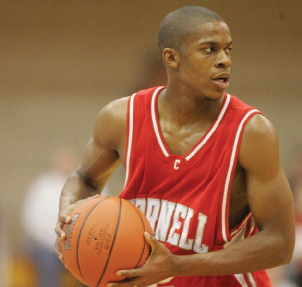
In a season full of great performances by Cornell basketball players, two were honored as the finest in their league. Jeomi Maduka '09 and Louis Dale '10 each earned the Ivy League Player of the Year award. Maduka is the first player in the thirty-six-year history of Big Red women's basketball to be so honored; Dale is the second for the men, joining Ken Bantum '85 from the 1984-85 team. The winner is determined by a vote of the league's coaches.
Maduka was the 2005-06 Ivy League Rookie of the Year and a second-team All-Ivy selection for the past two years. An outstanding forward, she led the Cornell women in points with 14.1 per game, in rebounds with 7.6 per game, and in steals, with 2.14 per game. She reached the 1,000-point career mark on March 8, making her the fifth player in Big Red women's basketball history to have 1,000 points, 500 rebounds, and 100 steals in her career.
And basketball may not even be Maduka's best sport. She is a standout in track and field and was named the Most Outstanding Performer for the second year in a row at the 2008 Indoor Heptagonal Championships while setting school records in the long jump and triple jump. She went on to earn All-American honors with an eighth-place finish in the long jump at the NCAA Women's Indoor Track and Field championships—which took place the day before the Big Red basketball team defeated Dartmouth to clinch a spot in the NCAA Tournament.
Maduka takes it all in stride. "I wanted to be able to play both sports, track and basketball, and commit myself to both equally. I could do that at Cornell," she says. "I have been juggling the two for a while. It does get difficult when I don't get to practice one as much as I'd like, but I'm used to it."
Dale, coming off an impressive freshman year that included an All-Ivy honorable mention selection, started all twenty-eight games at point guard for the Big Red and led the league in assists, averaging 4.9 per game. He also led the nation for most of the season in free-throw percentage, finishing at .897. (During one stretch, he sank fifty-two consecutive free throws.) Dale ranked second among the Big Red in scoring with 13.7 points per game and in rebounding with 4.4 rebounds per game.
Capping the honors, Maduka and Dale were both named to the Associated Press honorable mention All-American basketball team. Dale is the second Cornell man ever so honored—Bantum was the first—and Maduka is the first Cornell woman ever to receive this national recognition.
Where Did Those Great Players Come From?

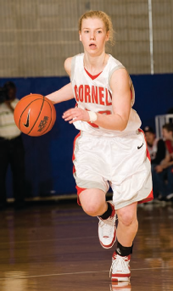
For the past twenty years, the only teams that mattered in Ivy League men's basketball were the two P's: Penn and Princeton. From 1989 to 2007, they won all the championships. For the women, it seemed that any team mattered except for Cornell. So this dual-championship year poses an interesting question: how did Cornell get great players like Jeomi Maduka '09 and Louis Dale '10—both named Ivy League Player of the Year— as well as a deadeye shooter like Ryan Wittman '10, son of the head coach of the NBA's Minnesota Timberwolves?
For head coaches Steve Donahue and Dayna Smith, recruiting their championship teams required a shift in both philosophy and geography. Donahue says that he had to get out of what he calls the "Northeast Corridor," the traditional recruiting grounds for Ivy athletics that includes anywhere north and east of Pennsylvania. Instead, he looked to the Midwest—and beyond. "We wanted to attack the Midwest because we felt kids from there would fit here culturally and environmentally," says Donahue. "These kids were not recruited by the other Ivy League schools, but they were a perfect fit for Cornell. We wanted to find players who could walk onto this campus and be excited."
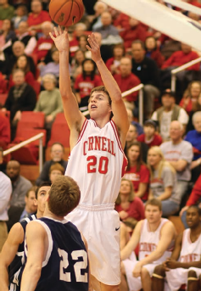
Dale, a five-foot-eleven guard from Birmingham, Alabama, says he was won over by the friendliness of the coaches, staff, and players. "And the campus is beautiful, so it just made my decision a lot easier," he adds. "I definitely wanted to go to a good academic school and get a good job after college." Forward Wittman—whose father, Randy, won a national championship playing for Bobby Knight's Indiana University team in 1981—echoes Dale, saying, "I loved what Cornell had to offer, and the academics were a big pull."
For the women, Smith says, "we haven't had the winning tradition here to get the top Ivy recruits, so we had to think outside the box. We looked to the Midwest and West, and even the world. We have Moïna Snyder '08 from France and Susie Doyle '11 from Ireland."
Guard Lauren Benson '10 came to Ithaca from Downers Grove, Illinois. She says that something about Cornell clicked on her first visit. "I felt really comfortable here," she says. "And at an Ivy League school, you can play Division I basketball and have an awesome academic experience. It's just a great opportunity." Senior Gretchen Gregg, a four-letter winner, says that Coach Smith's energy was another big plus. "And the positive reinforcement that the coaches give here, working on individual skills and bringing the players together as a team—they have done a tremendous job at that."
Perhaps the most unusual recruiting story comes from seven-foot center Jeff Foote '10, who grew up in nearby Lockwood, New York. It begins with one of the low points in Big Red basketball history, when Khaliq Gant '08 suffered a serious neck injury in practice on January 24, 2006. He was transported to Arnot Ogden Medical Center in Elmira, where head nurse Wanda Foote looked after him in the ICU. The Cornell players and coaches visited Gant almost every day, and Wanda Foote was so impressed by their compassion and unity that she told her son about it.
At the time, Jeff Foote was at St. Bonaventure and unhappy about his prospects—so his mother suggested that he think about transferring to Cornell. After talking with assistant coach Zach Spiker, he decided that Cornell's basketball program was a better fit for his abilities. Foote enrolled last year but had to sit out a season due to NCAA regulations. "That was frustrating because I wanted to get out there and play," he says, "but it was a good way for me to get a feel for everything. I was excited to be part of the program."
Success tends to breed success, and both head coaches hope that this year's championships will help to bring more strong players to the Hill. "Seeing us playing at this level should attract recruits who can take us even further," says Smith. "That's what we're looking for."
CAM intern Nick Corasaniti is a senior at Ithaca College and an aspiring journalist who has interned for Bill Moyers and written for a number of publications.


